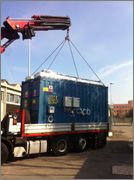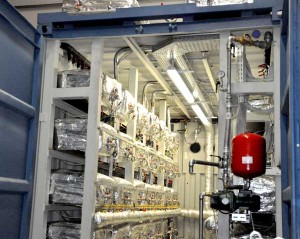
Italian Cold Fusion E-Cats and Hot Cats
 There are reports circulating on the Internet that Andrea Rossi, the Italian cold fusioneer, has shipped 1 megawatt E-CAT’s to customers including US DOD laboratories.
There are reports circulating on the Internet that Andrea Rossi, the Italian cold fusioneer, has shipped 1 megawatt E-CAT’s to customers including US DOD laboratories.
Rossi explained that the 1 MW plant that he demonstrated on October 28, 2011 had not been delivered to the confidential military customer. There were many glitches that first unit needed to have work done on: “hydraulics, distribution, common rail distribution, choice of coolant; didn’t have well-balanced distribution of 100+ of reactors.”
In contrast, he said: “The plant as of now is very mature.”
An additional unit was built for the military customer has just shipped. Rossi noted that it has now logged “many thousands of hours” of run time. The data from this plant easily corroborates the guaranteed coefficient of performance of 6 (six times more energy out than what is put in to make it run).
The plant that is now on its way to the U.S. customer is an upgraded version of the unit that was demonstrated on October 28, 2011. He just recently (April 30 – May 1, 2013) finished a 24-hour test of the unit before preparing it for shipping; and now, it is somewhere en route. Rossi estimates that it will take about 20 days to transport, and it could be a month before that unit is operational at the customer’s facility, where the customer “will be selling heat made by the plant.”
The Rossi version of cold fusion reportedly uses normal light hydrogen which is presented as a hot gas to a bed of nickel and other proprietary metal particles. Many small reactors populate racks on the inside of a standard 20 ft. shipping container. They are cooled with water that is converted to steam by the nuclear heat. Together the units in that 20 ft. container are said to produce more than a megawatt of constant thermal power.
The really exciting work that Rossi is doing is seen in the top image for this post. That’s his HOT CAT which reaches temperatures of more than 600 C!
Go Rossi. A rising Italian tide floats all boats!
Here’s a link to a paper just published on the Physics Internet Journal Arxiv from a multi-national team assembled to independently study and report on Rossi’s demonstration apparatus… It is wildly positive, read more here…
The enabling techniques, materials, and results are very much in line with the deuterium based gas nano-particle experimental results I have tested in different sized metal flasks.
I always wanted to do what Rossi has done and just build a tremendous number of small devices and engineer the common rack system and heat harvesting mechanisms to turn out megawatts of useful power.
Here’s a picture of gas/nanoparticle-catalyst experiments next to our quadropole mass spec used to measure helium output in real time. Read what Wired Magazine had to say in their report on my work with this particular experimental set-up here.


